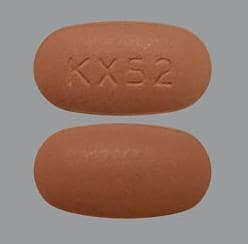Dosage Forms
Excipient information presented when available (limited, particularly for generics); consult specific product labeling.
Tablet, Oral:
Auryxia: Ferric iron 210 mg (ferric citrate 1 g) [contains fd&c blue #2 aluminum lake, fd&c red #40 aluminum lake, fd&c yellow #6 aluminum lake]
Pharmacology
Mechanism of Action
Hyperphosphatemia: Lowers serum phosphate by binding to dietary phosphate in the GI tract; product precipitates as insoluble ferric phosphate and is excreted in feces.
Iron deficiency anemia: Oxidized ferric iron circulates bound to transferrin where it is incorporated into hemoglobin after it is transported through enterocytes into the blood.
Use: Labeled Indications
Hyperphosphatemia: For the control of serum phosphorus levels in patients with chronic kidney disease (CKD) receiving dialysis
Iron deficiency anemia: Treatment of iron deficiency anemia in patients with CKD not on dialysis
Contraindications
Iron overload syndromes (eg, hemochromatosis)
Dosage and Administration
Dosing: Adult
Note: Each tablet contains 210 mg of ferric iron equivalent to 1 g ferric citrate.
Hyperphosphatemia: Oral:
Initial: Two tablets (420 mg ferric iron) 3 times daily
Maintenance: Increase or decrease dose by 1 tablet or 2 tablets (ferric iron 210 mg to 420 mg) as needed at 1-week or longer intervals to achieve target serum phosphorus levels (maximum dose: 12 tablets [ferric iron 2,520 mg] daily).
Iron deficiency anemia (nondialysis CKD): Oral: One tablet (ferric iron 210 mg) 3 times daily; titrate dose as needed to achieve and maintain target hemoglobin level (maximum dose: 12 tablets [ferric iron 2,520 mg] daily). Note: In one clinical trial, dose titration occurred at 4-week intervals to achieve desired hemoglobin levels; dose was increased only if serum phosphorus level ≥3 mg/dL, was decreased if serum phosphorus level <2.5 mg/dL, and temporarily discontinued if serum phosphorus level <2 mg/dL (Fishbane 2017).
Dosing: Geriatric
Refer to adult dosing.
Administration
Administer with meals. Do not chew or crush tablets (may discolor mouth and teeth).
Dietary Considerations
Ensure adherence with prescribed diet.
Storage
Store at 20°C to 25°C (68°F to 77°F); excursions are permitted between 15°C and 30°C (59°F and 86°F). Protect from moisture.
Ferric Citrate Images
Drug Interactions
Alpha-Lipoic Acid: Iron Preparations may decrease the absorption of Alpha-Lipoic Acid. Alpha-Lipoic Acid may decrease the absorption of Iron Preparations. Consider therapy modification
Baloxavir Marboxil: Polyvalent Cation Containing Products may decrease the serum concentration of Baloxavir Marboxil. Avoid combination
Bictegravir: Iron Preparations may decrease the serum concentration of Bictegravir. Management: Bictegravir, emtricitabine, and tenofovir alafenamide can be administered with iron preparations under fed conditions, but coadministration with or 2 hours after an iron preparation is not recommended under fasting conditions. Consider therapy modification
Bisphosphonate Derivatives: Polyvalent Cation Containing Products may decrease the serum concentration of Bisphosphonate Derivatives. Management: Avoid administration of oral medications containing polyvalent cations within: 2 hours before or after tiludronate/clodronate/etidronate; 60 minutes after oral ibandronate; or 30 minutes after alendronate/risedronate. Exceptions: Pamidronate; Zoledronic Acid. Consider therapy modification
Cefdinir: Iron Preparations may decrease the serum concentration of Cefdinir. Red-appearing, non-bloody stools may also develop due to the formation of an insoluble iron-cefdinir complex. Management: Avoid concurrent cefdinir and oral iron when possible. Separating doses by several hours may minimize interaction. Iron-containing infant formulas do not appear to interact with cefdinir. Consider therapy modification
Deferiprone: Polyvalent Cation Containing Products may decrease the serum concentration of Deferiprone. Management: Separate administration of deferiprone and oral medications or supplements that contain polyvalent cations by at least 4 hours. Consider therapy modification
Dimercaprol: May enhance the nephrotoxic effect of Iron Preparations. Avoid combination
Dolutegravir: Iron Preparations may decrease the serum concentration of Dolutegravir. Management: Administer dolutegravir at least 2 hours before or 6 hours after oral iron. Administer dolutegravir/rilpivirine at least 4 hours before or 6 hours after oral iron. Alternatively, dolutegravir and oral iron can be taken together with food. Consider therapy modification
Eltrombopag: Polyvalent Cation Containing Products may decrease the serum concentration of Eltrombopag. Management: Administer eltrombopag at least 2 hours before or 4 hours after oral administration of any polyvalent cation containing product. Consider therapy modification
Entacapone: Iron Preparations may decrease the serum concentration of Entacapone. Management: Consider separating doses of the agents by 2 or more hours to minimize the effects of this interaction. Monitor for decreased therapeutic effects of levodopa during concomitant therapy, particularly if doses cannot be separated. Consider therapy modification
Levodopa: Iron Preparations may decrease the serum concentration of Levodopa. Only applies to oral iron preparations. Management: Consider separating doses of the agents by 2 or more hours to minimize the effects of this interaction. Monitor for decreased therapeutic effects of levodopa during concomitant therapy, particularly if doses cannot be separated. Consider therapy modification
Levothyroxine: Iron Preparations may decrease the serum concentration of Levothyroxine. Management: Separate oral administration of iron preparations and levothyroxine by at least 4 hours. Separation of doses is not required with parenterally administered iron preparations or levothyroxine. Consider therapy modification
Methyldopa: Iron Preparations may decrease the serum concentration of Methyldopa. Consider therapy modification
PenicillAMINE: Polyvalent Cation Containing Products may decrease the serum concentration of PenicillAMINE. Management: Separate the administration of penicillamine and oral polyvalent cation containing products by at least 1 hour. Consider therapy modification
Phosphate Supplements: Iron Preparations may decrease the absorption of Phosphate Supplements. Management: Administer oral phosphate supplements as far apart from the administration of an oral iron preparation as possible to minimize the significance of this interaction. Exceptions: Sodium Glycerophosphate Pentahydrate. Consider therapy modification
Quinolones: Iron Preparations may decrease the serum concentration of Quinolones. Management: Give oral quinolones at least several hours before (4 h for moxi- and sparfloxacin, 2 h for others) or after (8 h for moxi-, 6 h for cipro/dela-, 4 h for lome-, 3 h for gemi-, and 2 h for levo-, nor-, oflox-, pefloxacin, or nalidixic acid) oral iron. Exceptions: LevoFLOXacin (Oral Inhalation). Consider therapy modification
Raltegravir: Polyvalent Cation Containing Products may decrease the serum concentration of Raltegravir. Management: Administer raltegravir 2 hours before or 6 hours after administration of the polyvalent cations. Dose separation may not adequately minimize the significance of this interaction. Consider therapy modification
Tetracyclines: May decrease the absorption of Iron Preparations. Iron Preparations may decrease the serum concentration of Tetracyclines. Management: Avoid this combination if possible. Administer oral iron preparations at least 2 hours before, or 4 hours after, the dose of the oral tetracycline derivative. Monitor for decreased therapeutic effect of oral tetracycline derivatives. Exceptions: Eravacycline. Consider therapy modification
Trientine: Polyvalent Cation Containing Products may decrease the serum concentration of Trientine. Management: Avoid concomitant administration of trientine and oral products that contain polyvalent cations. If oral iron supplements are required, separate the administration by 2 hours. If other oral polyvalent cations are needed, separate administration by 1 hour. Consider therapy modification
Adverse Reactions
>10%: Gastrointestinal: Darkening of stools (19% to 22%), diarrhea (21%), constipation (8% to 18%), nausea (10% to 11%)
1% to 10%:
Endocrine & metabolic: Hyperkalemia (5%)
Gastrointestinal: Vomiting (7%), abdominal pain (5%)
Respiratory: Cough (6%)
Warnings/Precautions
Concerns related to adverse effects:
- Iron toxicity: May increase serum iron, ferritin, and transferrin saturation (TSAT), which may lead to excessive elevations in iron stores. Evaluate serum iron, ferritin, and TSAT at baseline and during therapy.
- Stool discoloration: May cause discolored (dark) stools related to iron content.
Concurrent drug therapy issues:
- Iron supplements: Patients receiving parenteral iron supplementation may require a dose reduction or discontinuation when ferric citrate is initiated.
- Drug-drug interactions: Potentially significant interactions may exist, requiring dose or frequency adjustment, additional monitoring, and/or selection of alternative therapy. Consult drug interactions database for more detailed information.
Other warnings/precautions:
- Overdose: Contains iron, a leading cause of fatal poisoning in children <6 years of age. Keep out of reach of children; in case of accidental overdose, immediately contact a poison control center or a health care provider.
Monitoring Parameters
Serum iron, ferritin, and transferrin saturation (TSAT) at baseline and during therapy; serum phosphorus (periodically)
Pregnancy
Pregnancy Considerations
Maternal iron requirements increase during pregnancy. Adequate iron concentrations to the fetus can be maintained regardless of maternal iron status, except in severe cases of anemia (IOM 2001). Untreated iron deficiency and iron deficiency anemia (IDA) in a pregnant female may be associated with adverse events, including low birth weight, preterm birth, or increased perinatal mortality (ACOG 95 2008; IOM 2001; Pavord 2012).
In general, treatment of iron deficiency or IDA in pregnancy is the same as in non-pregnant females. The majority of studies note iron therapy improves maternal hematologic parameters; however, information related to clinical outcomes in the mother and neonate is limited (Siu 2015).
Oral preparations are generally sufficient; however, parenteral iron therapy may be used in females who cannot tolerate or will not take oral iron, in cases of severe iron deficiency, or when malabsorption is present (ACOG 95 2008; Pavord 2012).
Iron overdose in pregnant women may lead to an increased risk of fetal malformations, spontaneous abortion, and gestational diabetes.
Patient Education
What is this drug used for?
- It is used to lower high phosphate levels.
- It is used to treat anemia.
Frequently reported side effects of this drug
- Cough
- Dark stools
Other side effects of this drug: Talk with your doctor right away if you have any of these signs of:
- Severe nausea
- Severe vomiting
- Severe diarrhea
- Severe constipation
- Signs of a significant reaction like wheezing; chest tightness; fever; itching; bad cough; blue skin color; seizures; or swelling of face, lips, tongue, or throat.
Note: This is not a comprehensive list of all side effects. Talk to your doctor if you have questions.
Consumer Information Use and Disclaimer: This information should not be used to decide whether or not to take this medicine or any other medicine. Only the healthcare provider has the knowledge and training to decide which medicines are right for a specific patient. This information does not endorse any medicine as safe, effective, or approved for treating any patient or health condition. This is only a brief summary of general information about this medicine. It does NOT include all information about the possible uses, directions, warnings, precautions, interactions, adverse effects, or risks that may apply to this medicine. This information is not specific medical advice and does not replace information you receive from the healthcare provider. You must talk with the healthcare provider for complete information about the risks and benefits of using this medicine.

